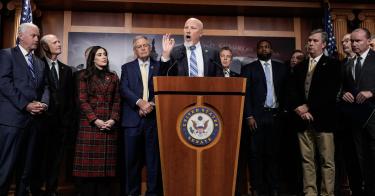We’re in a new year, but the headlines from Capitol Hill feel old.
Once again, Congress has been debating its annual spending bills. And once again, a fiscal deadline looms: There will be a partial government shutdown on Friday unless Congress passes something in time.
Considering that the gross national debt is now over $100,000 for every man, woman and child in the country, having Congress focus on spending might seem like a good thing.
Unfortunately, only a few dozen legislators seem concerned about unsustainable and inflationary deficit spending. A much larger group is focused on delivering taxpayer-funded handouts to selected special interests.
Americans are understandably exhausted by the seemingly endless drama and dysfunction flowing from the nation’s capital, especially when there is so little to show for it. Congress hasn’t done its job of passing all the spending bills on time since the Clinton administration.
>>> Out-of-Control Government Spending Has Real Consequences
Here are three core problems with the current budget problems, along with solutions to address each.
PROBLEM 1: Congress struggles to complete the budget and spending problem on time, leading to awkward continuing resolutions and potential shutdowns.
SOLUTION: While it might seem easy to blame this failure on partisanship or incompetence, the simple fact is that the U.S. federal government has swollen into an incomprehensibly large mass of bureaucracies and programs.
Debating the proper amount to spend on core priorities such as national defense and veterans’ benefits is already a heavy lift. Haggling over funding for thousands of questionable line items such as maple syrup subsidies, the African Development Foundation and Title X Family Planning program is something else entirely.
Add to that the enormous amount of effort that members offices and the appropriations committees put into reviewing tens of thousands of requests for earmarks– aka pork projects – and it’s no wonder that Congress has a hard time reaching consensus.
Streamlining the federal government would not only help move the budget closer to balance, but it would also dramatically simplify the spending process.
PROBLEM 2: Spending bills get merged into “omnibus” packages that are thousands of pages long, and members are often expected to vote with only a few hours’ notice.
Another part of the imbalance that rank-and-file members face is that Congressional Budget Office analysis of appropriations bills is only delivered to a handful of high-ranking offices. This allows appropriators and leadership to break budget rules while hiding that fact from the rest of the world.
SOLUTION: Shrinking the number of programs and agencies would reduce the page count of spending packages. However, that wouldn’t address the inherently broken nature of forcing legislators to vote on important bills without having enough time to properly evaluate them.
Congress should have at least a week’s notice to vote on regular spending bills to allow for proper review and debate. In addition, the “score” of the bills should be published just like any other bill.
>>> FY 2024 Senate Appropriations: Fiddling While America Burns
PROBLEM 3: The federal government is on pace for a $2 trillion deficit, an amount that is unprecedented by any measure when there is no major war or sharp recession to explain it. However, the spending bills that Congress bickers over every year cover less than one-third of federal spending, because the rest is on autopilot.
SOLUTION: The budget process should be more comprehensive, forcing Congress to seriously look at the totality of spending and address (rather than ignore) dangerously high deficits.
Americans seeking an example of responsible governance should look at Switzerland.
The Swiss enacted a system in 2003 that keeps overall spending levels in check based on the business cycle, allowing modest deficits during recessions that are paid off during growth years. As a result, their debt has remained at a healthy level while Uncle Sam’s debts have skyrocketed.
Taxpayers should be under no illusion that any of these solutions would be an easy fix, especially since they involve removing power and control from the big-spending establishment.
The last time Washington did anything meaningful to reduce deficits was because of pressure (and political consequences) from the tea party movement. The nation needs something similar once again to stop the endless flow of red ink from drowning the economy.
This piece originally appeared in MSN



